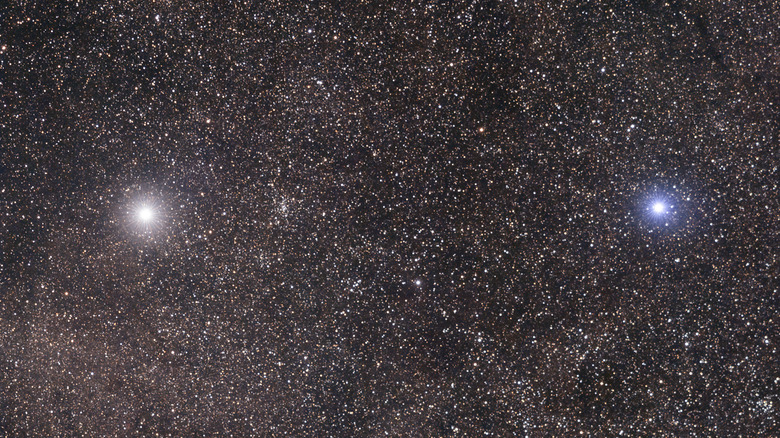What Is The Nearest Star To Earth In Our Solar System?
For as long as humanity has looked up at the stars, people have been endlessly curious and fascinated about what might lie in these far-away lands. With the scientific revolution and Space Race of the 1960s, many have wondered which star is the closest to planet Earth, and would there be any habitable lands for people and creatures alike to survive in the alien setting. Luckily, scientists have been able to pinpoint exactly what star system that is: the infamous Alpha Centauri system.
There have been many science fiction stories about humanity traveling to the distant worlds in the Alpha Centauri system. Works, like Ben Bova's book, "Flight of Exiles," which catches up with a group of scientists 50 years after they escaped from Earth on their way to the planet's nearest star system, Alpha Centauri. How does this hold up with the real scientific knowledge of our interstellar neighbor, and would humans even be able to cover the distance to actually see it?
Our nearest star is 4.25 light years away
The Alpha Centauri system is 4.35 light-years away from our beloved planet Earth, and it is actually a triple-star system, making it a cosmic rarity being a part of only 10% of systems that share the same trait (via the Daily Beast). The first two stars in the system — Alpha Centauri A and Alpha Centauri B (both pictured) — are approximately 23 astronomical units away from each other. Their sister star, Proxima Centauri, is roughly 600 times that distance away from them, however, but is only 4.25 light-years away from Earth, making it the closest star to our home planet.
Humanity would have to travel for a very, very long time to reach Proxima Centauri with the best cutting-edge technology available. If humanity were to travel on a spaceship that goes at the speed of the Parker Solar Probe — up to 364,621 miles an hour — it would take humanity around 6,300 years to reach our nearest neighbor, according to MIT. Needless to say, if the opportunity arises for you to partake in this journey, you best make sure you can tolerate your crew for at least a couple hundred generations.
Are there Habitable Planets in Alpha Centauri?
Even in a scenario where humanity somehow makes the intergenerational voyage to the Alpha Centauri system, the trip may be entirely for nothing if there is no place for people to forge a home. So that begs the question, are there habitable worlds orbiting any of the stellar objects? Well, astronomers aren't entirely sure, but it's definitely a possibility. In 2016 astronomers identified an exoplanet that is 1.3 times Earth's size, and also has the possibility to contain liquid water, per Space. The planet was appropriately named Proxima b and would be the closest planet to colonize.
Researchers are skeptical if the planet would be able to support Earth-life, but that's mostly due to incomplete data. Some astronomers wonder if the planet is so close to Proxima Centauri that only one side faces the celestial object at all times. This would make one side of Proxima b a burning hot hellscape, whereas the other side would be a frozen desert. Other factors, such as Proxima Centauri being a red dwarf, can affect the ability of life to exist. Usually, red dwarfs are more erratic and emit more deadly radiation in their systems than stars like our sun, which allows for a stable habitat.


